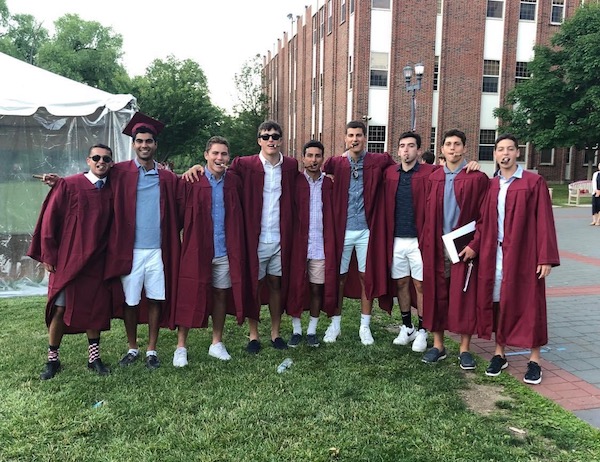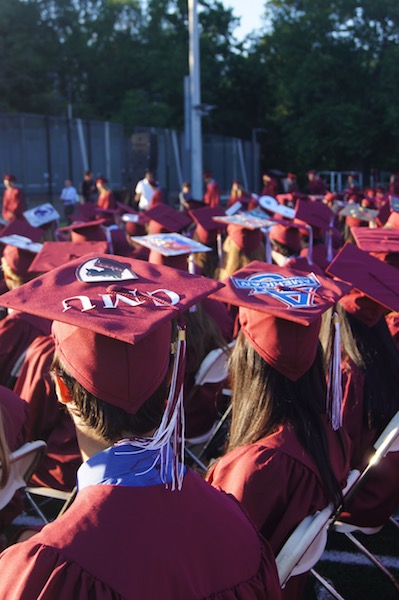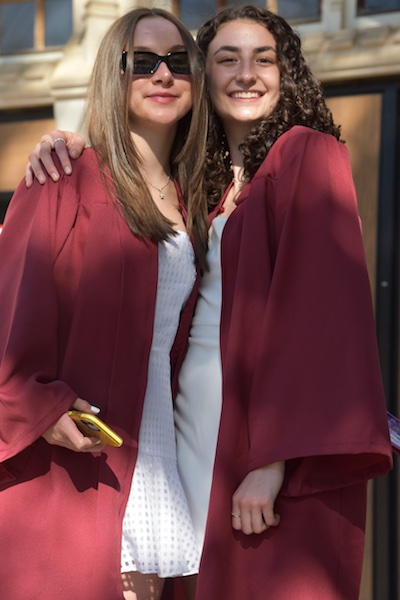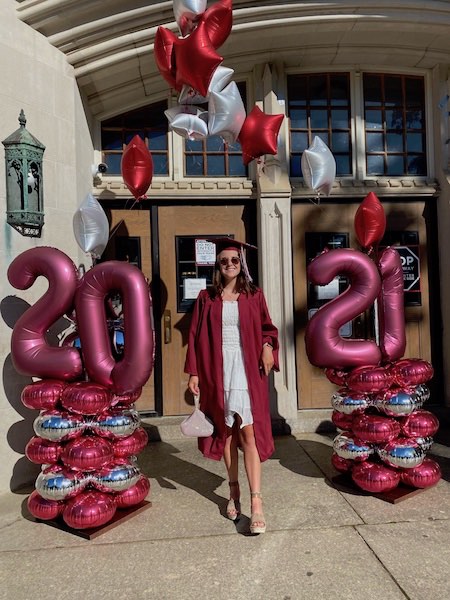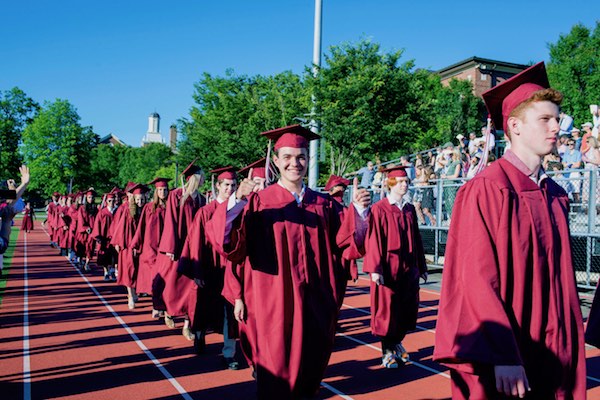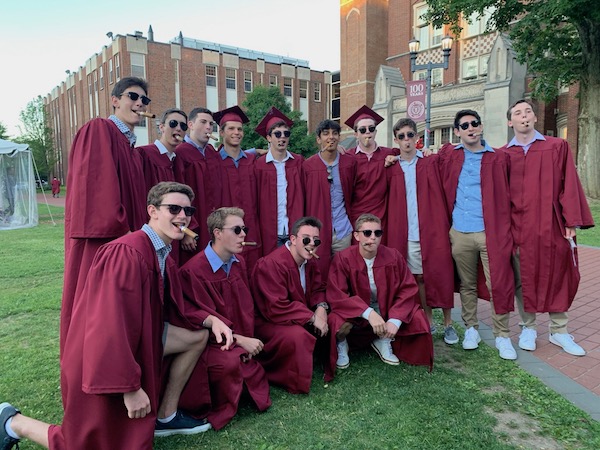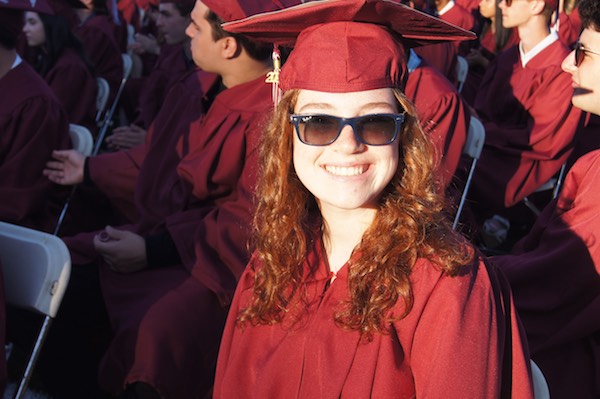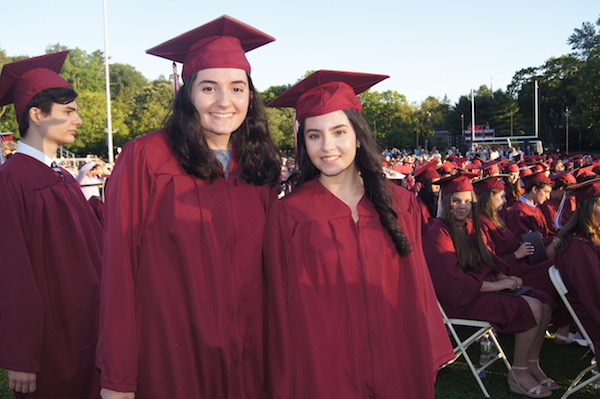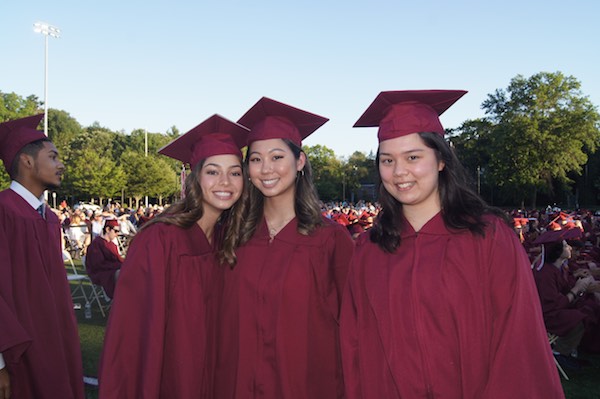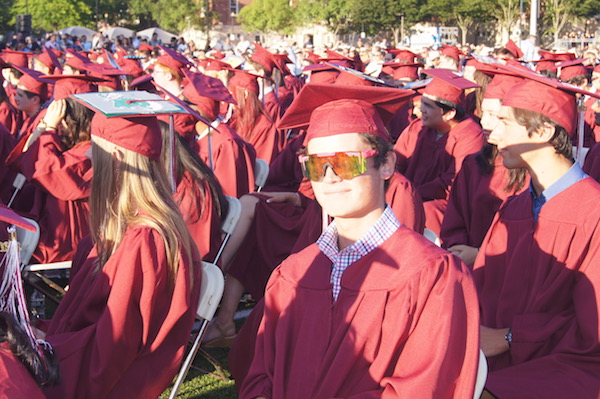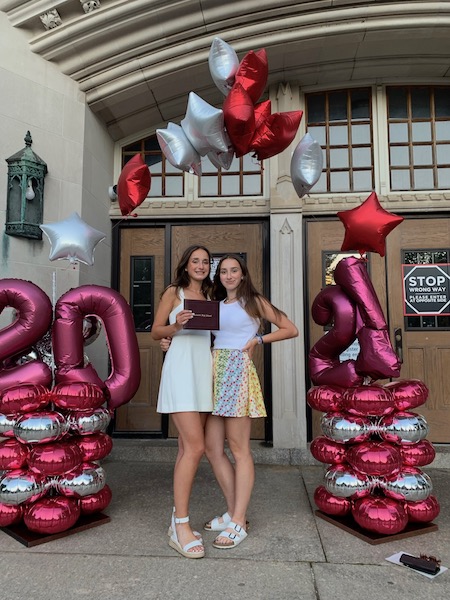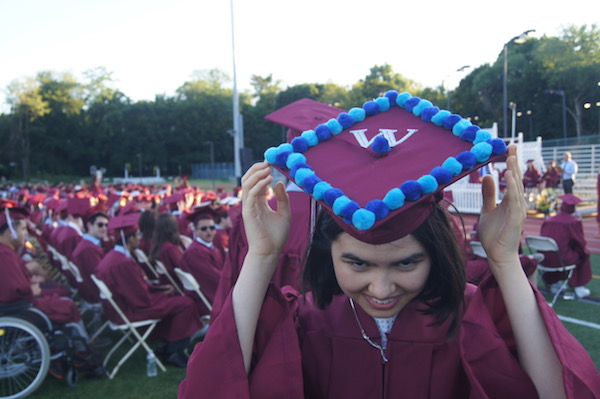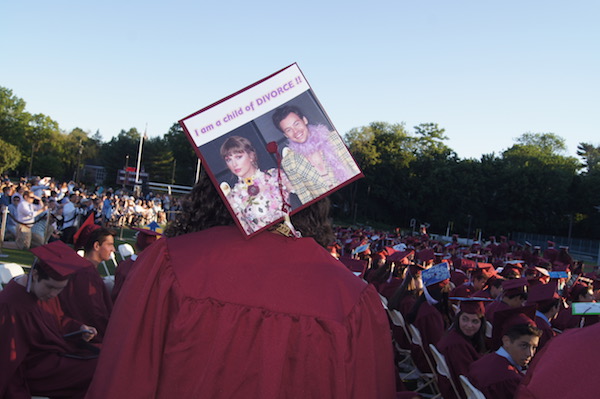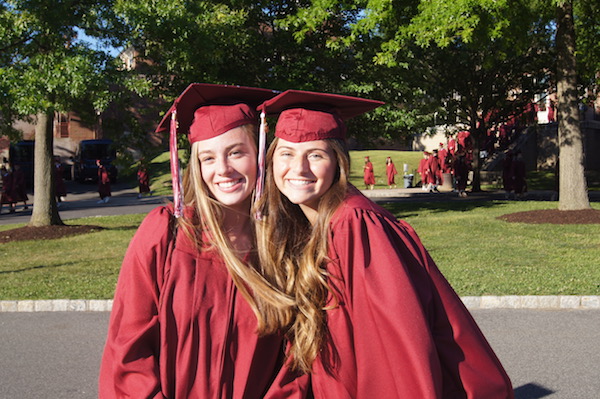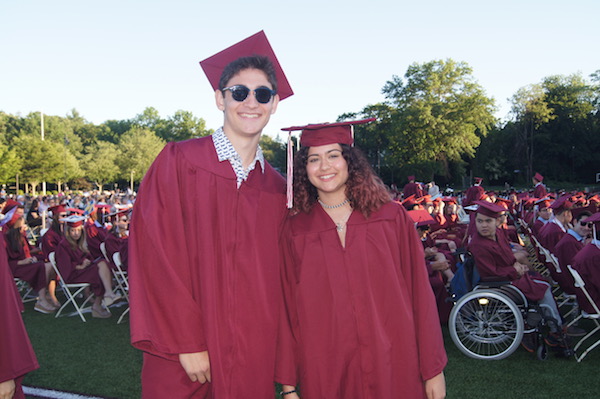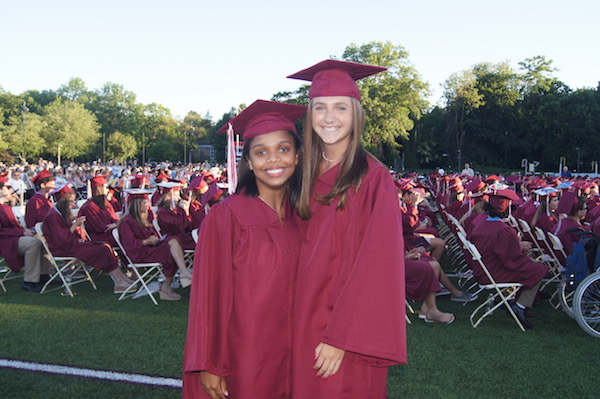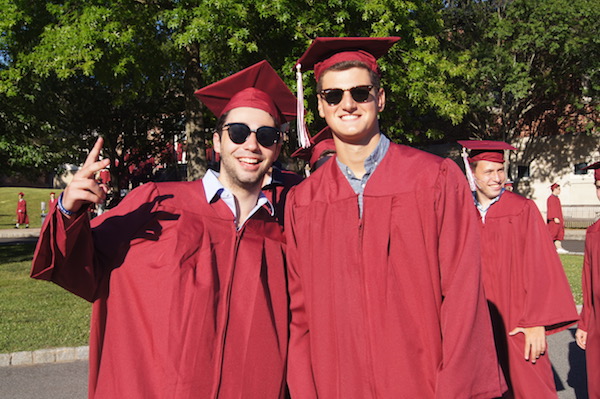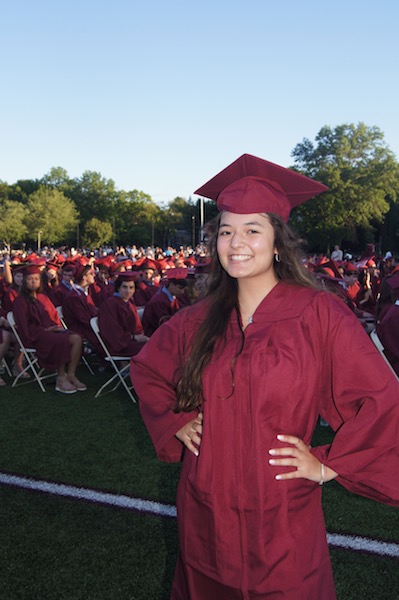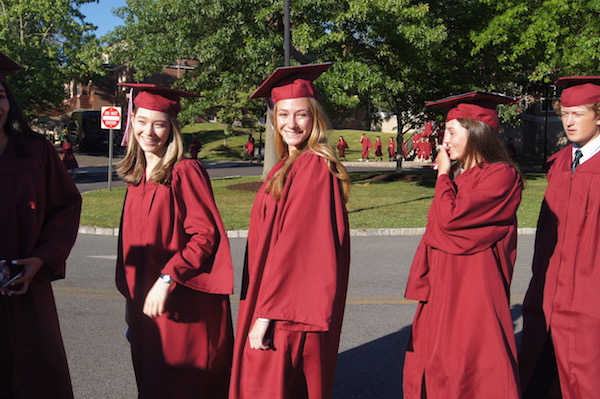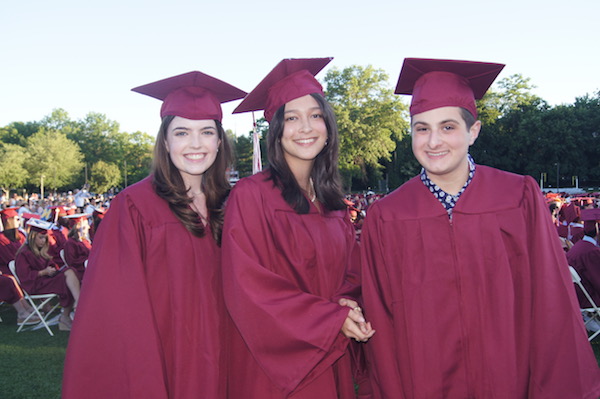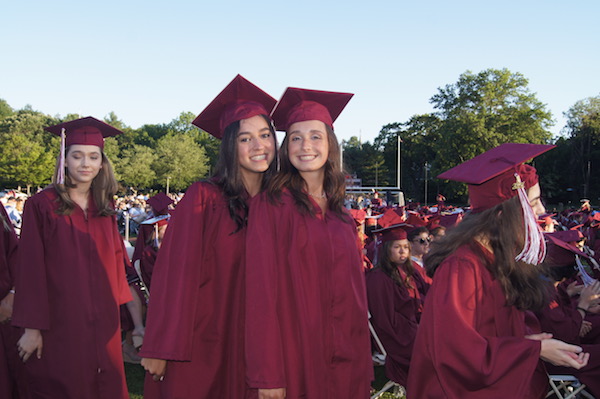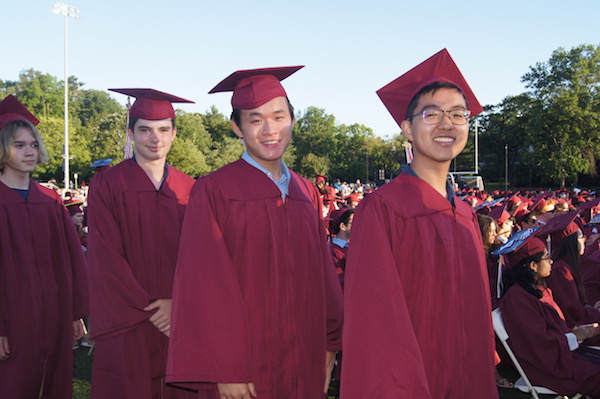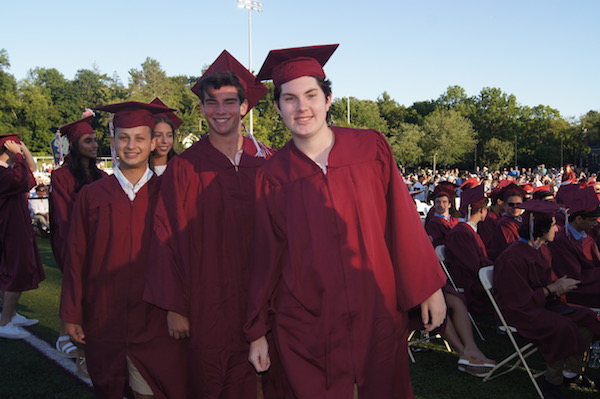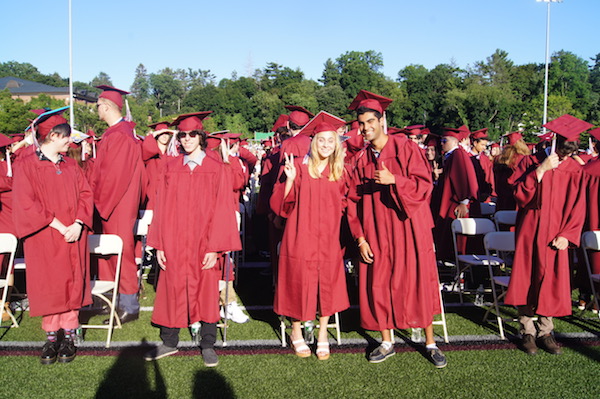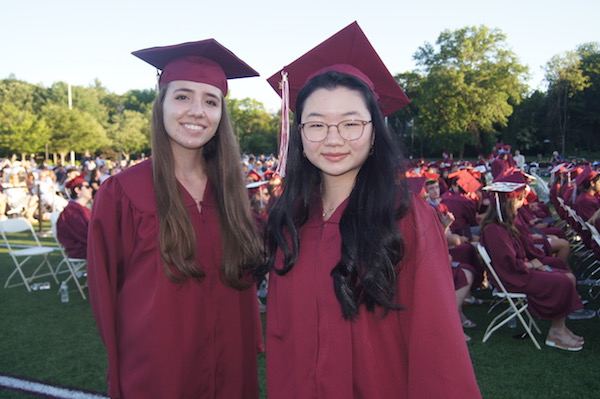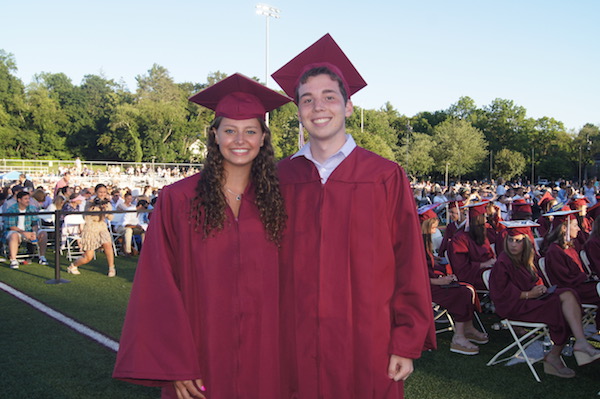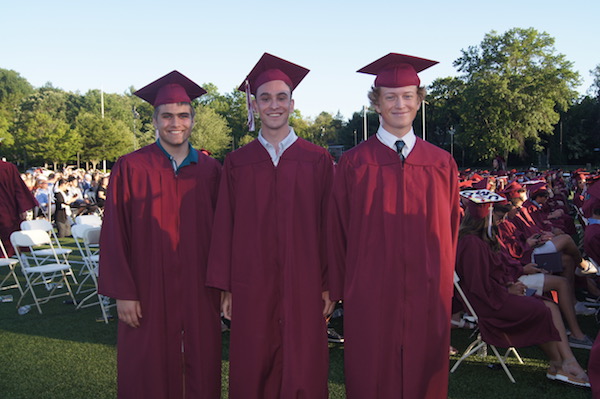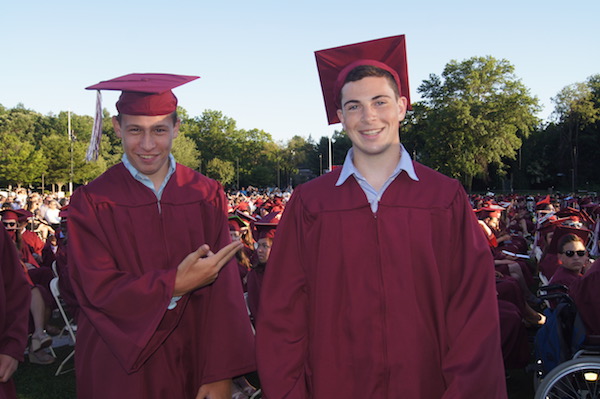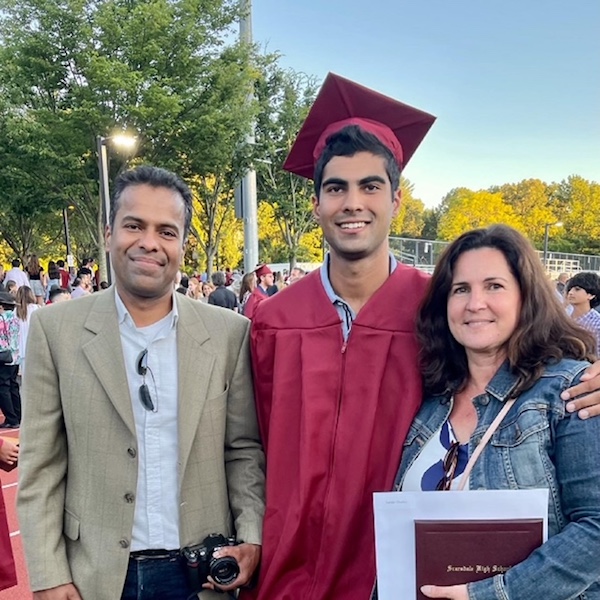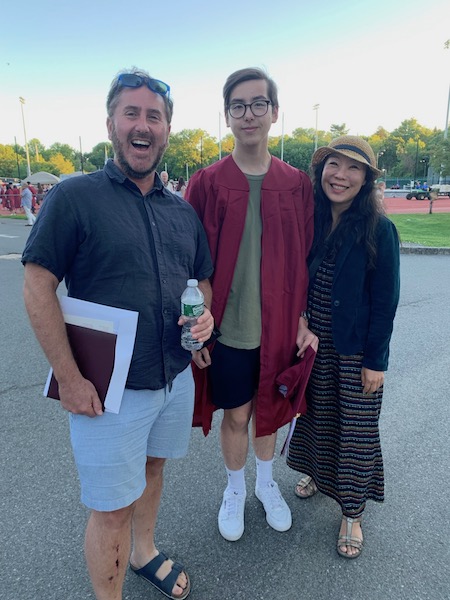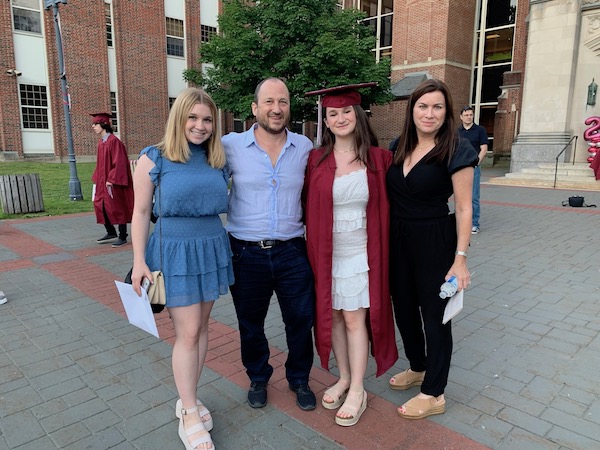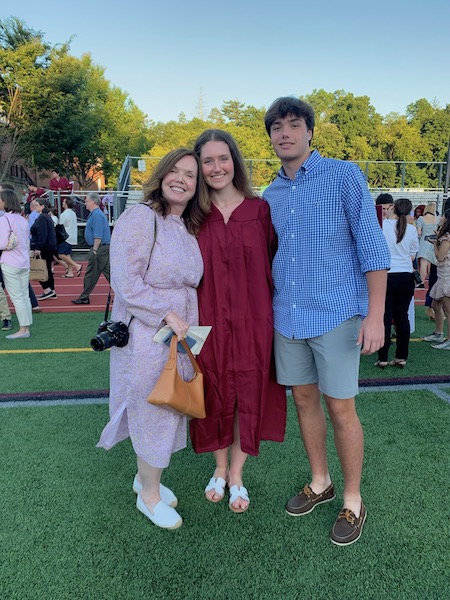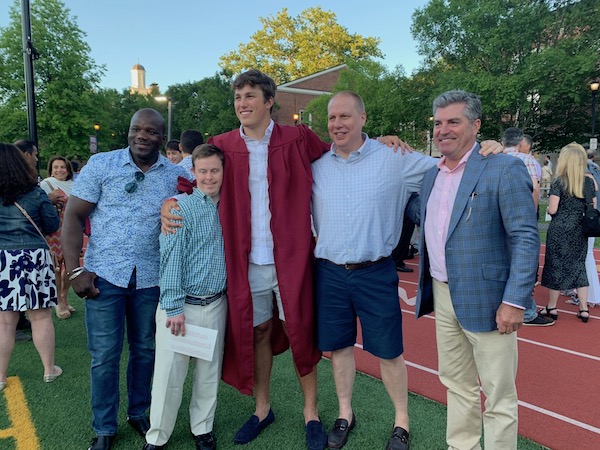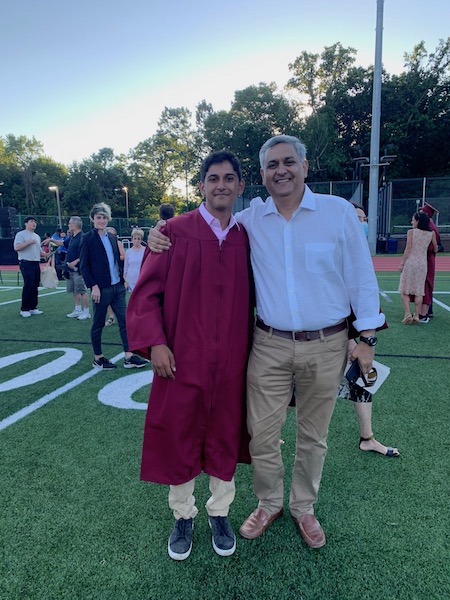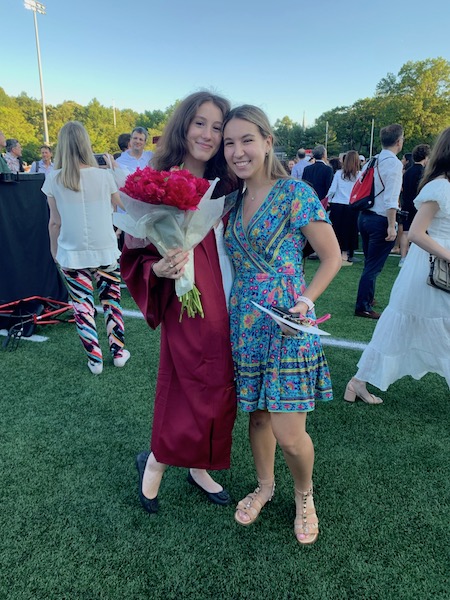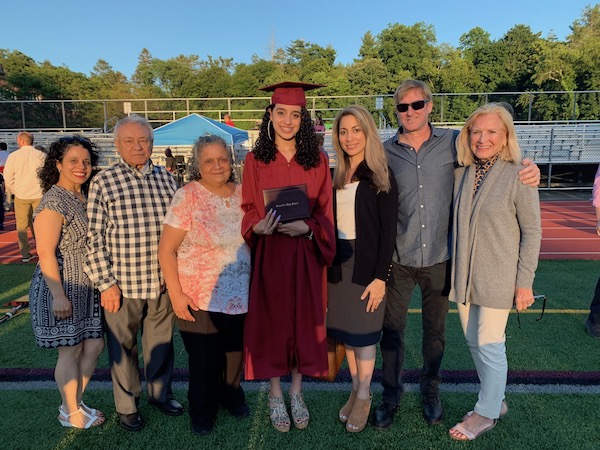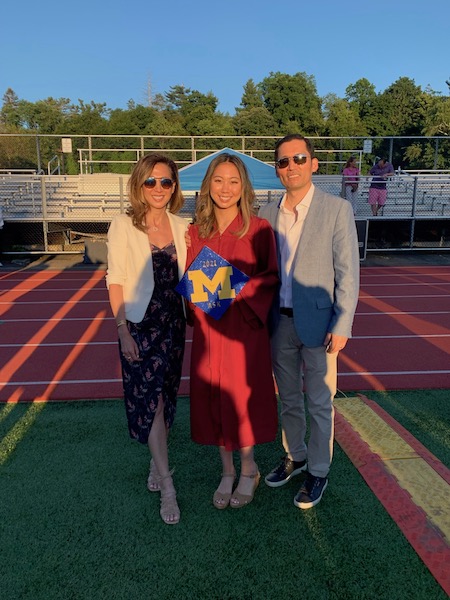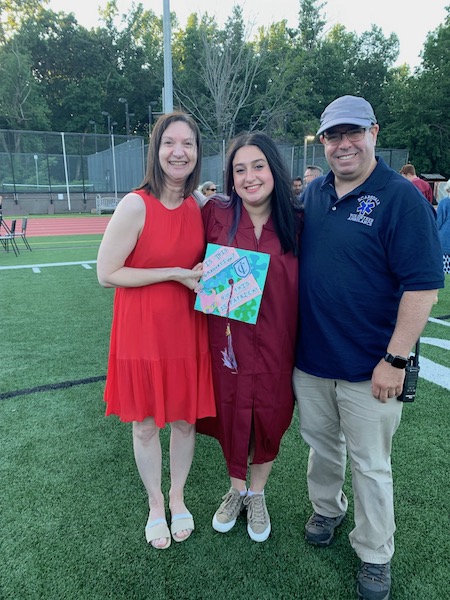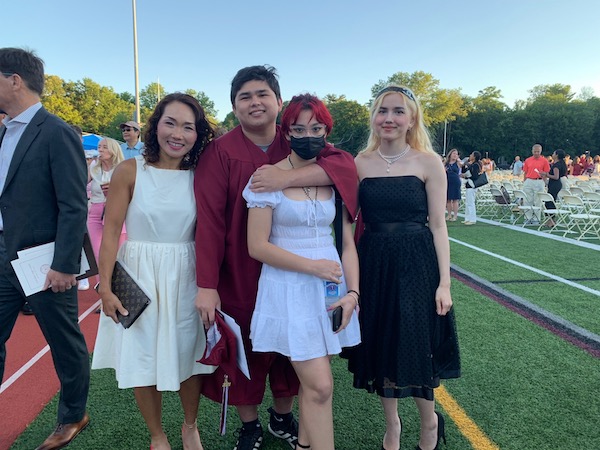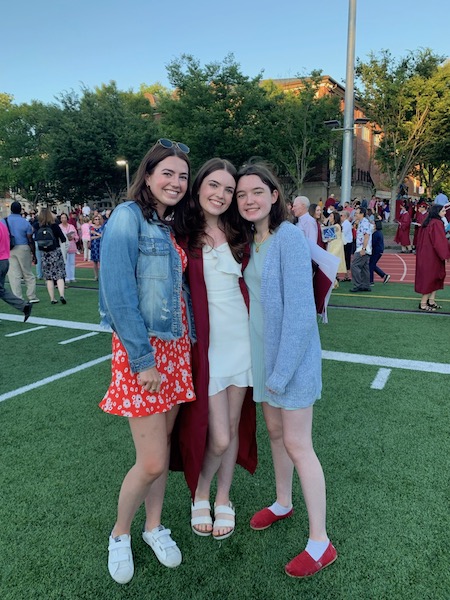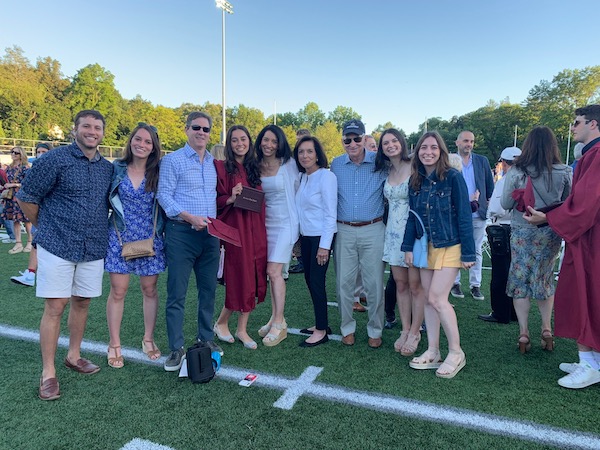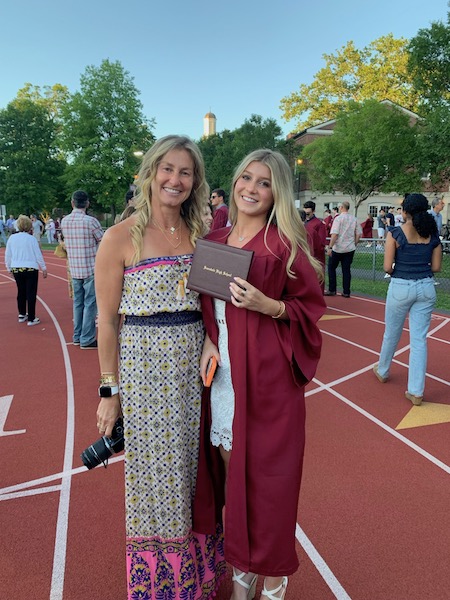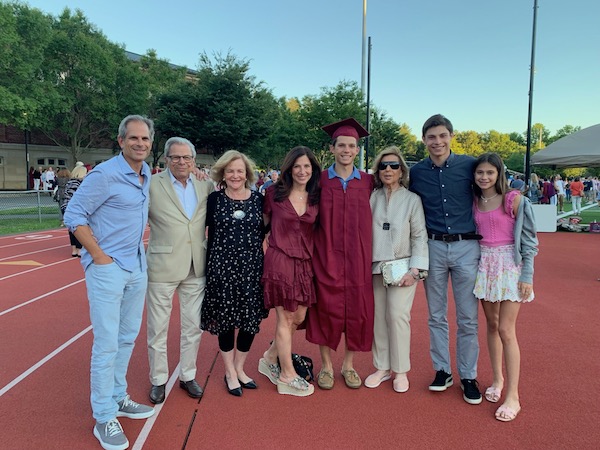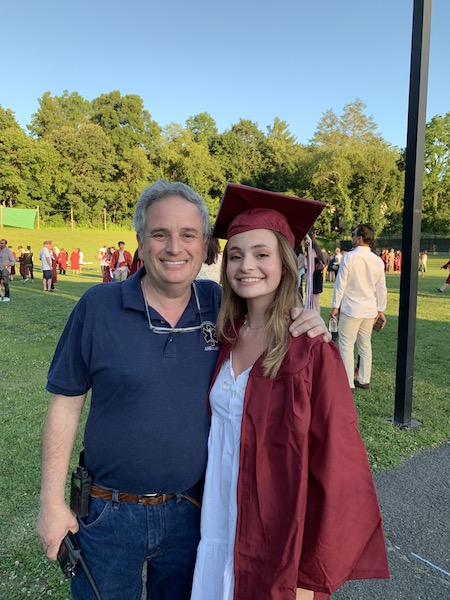District Announces Plans for the Fall: In School Instruction Only, Masks Required
- Details
- Written by: Joanne Wallenstein
- Hits: 1910
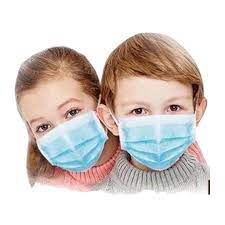 School Superintendent Thomas Hagerman updated the community on the district’s plans for the fall this week. He explained, that in the absence of any direction from the Governor and the NYS Health Department, the district is currently basing their decisions on guidance from the Centers for Disease Control and Prevention (CDC) and the American Academy of Pediatrics (AAP).
School Superintendent Thomas Hagerman updated the community on the district’s plans for the fall this week. He explained, that in the absence of any direction from the Governor and the NYS Health Department, the district is currently basing their decisions on guidance from the Centers for Disease Control and Prevention (CDC) and the American Academy of Pediatrics (AAP).
The headline is that school will be in person this year and students will be required to wear masks indoors.
Here are the specifics from Dr. Hagerman:
All students are expected to attend school in person, five days a week. We will be utilizing our schools’ regular, pre-pandemic schedules. These schedules can be found in the student handbook for each building.
Hybrid instruction will not be used this year.
Remote/Virtual instruction will be employed only in emergent situations if/when a full class is required to quarantine/isolate, or if the State or County closes our schools due to a severe outbreak.
Activities, extracurriculars, and athletics are scheduled to proceed according to pre-pandemic practices. Health and safety protocols to mitigate the risks associated with COVID-19 are being finalized in accordance with CDC guidance for schools. The AAP guidance will also be used to inform our work for youth sports and physical activity. The protocols will be posted on the Scarsdale High School Athletics website and communicated to participants and their families as they are completed.
Per CDC guidance, all individuals will be expected to wear face coverings/masks while inside District facilities and on District transportation, regardless of vaccination status, starting at the beginning of the school year. This is the same practice as last school year.
Masks will not be required outdoors, although unvaccinated individuals will be encouraged to wear them at all times.
Standard health/safety mitigation strategies from last year will continue into the year ahead, including cleaning/disinfecting protocols; physical distancing, to the extent possible; handwashing and respiratory hygiene; contact tracing; and the like.
The Scarsdale Public Schools will also continue to seek out and offer vaccination opportunities/information and COVID-19 screening testing.
What do parents think of the new guidelines?
Sarah Hopkins said, “I am thrilled school will be full-time, and not "hybrid." I am disappointed the district has not led with requiring vaccinations for all staff and teachers. Vaccinations, not masking, are the strongest mitigators of risk. I do not understand why the district continues to promote disinfection of buildings when this has been wholly unnecessary and unscientific.
As we enter the second school year of masking young children, it’s worth noting W.H.O. and C.D.C./A.A.P. are in total disagreement on this issue. Many similar countries do not enforce masking in schools and there is no evidence of a net benefit. The CDC based its decision to recommend masks even for vaccinated individuals on a study of sex parties in Provincetown, MA. Hardly analogous to schools! Emphasizing masking over vaccines make vaccines appear less essential and powerful than they are. These vaccines are nothing short of miraculous, and we should be doing everything in our power to vaccinate as many adults as possible.
It’s also worth noting the district chose not to follow the AAPs advice last summer to keep schools fully open, even if it meant not distancing. Why it has now decided to follow AAP was not explained.
Lastly, I had hoped the district would address mental health issues head on. Students have suffered this year, there are ample data to demonstrate that. I had hoped we would have a plan in place to help kids as they reenter full-time school.”
Diane Gurden added, “I plan to go with the flow as long as the words "hybrid" or "remote" do not surface. I also hope that we regularly have check-ins, since the environment is so dynamic from both a variant and vaccination level perspective, and that we have transparency related to why decisions are being made or changed. Since the environment is so complex, leveraging the diverse medical expertise in the community would benefit us all, so I hope that we do more of that this year.”
What do you think of the district’s plans? Please comment below.
Can Scarsdale Require Kids to be Vaccinated Before Returning to School?
- Details
- Written by: Joanne Wallenstein
- Hits: 3041
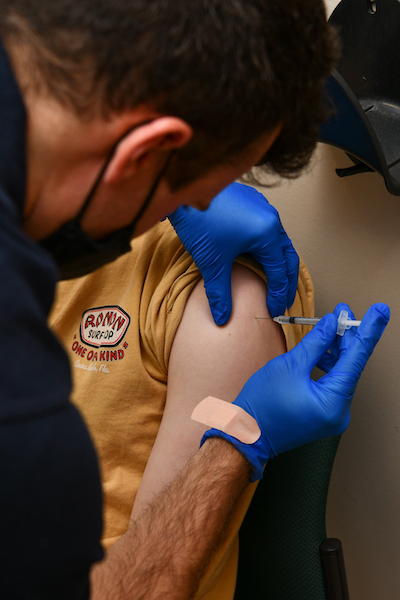 In May, US News reported that a database maintained by the Chronicle of Higher Education indicated that more than 360 public and private colleges across the U.S. will require students to get a coronavirus vaccine, and experts expect more schools to follow suit. The State University of New York is also requiring students to be immunized but Governor Cuomo cautioned, “They (the FDA) would have to give it full approval before September, otherwise SUNY, CUNY could not mandate. If it doesn't have the full approval, you cannot legally mandate … we believe they will do that in the near future.”
In May, US News reported that a database maintained by the Chronicle of Higher Education indicated that more than 360 public and private colleges across the U.S. will require students to get a coronavirus vaccine, and experts expect more schools to follow suit. The State University of New York is also requiring students to be immunized but Governor Cuomo cautioned, “They (the FDA) would have to give it full approval before September, otherwise SUNY, CUNY could not mandate. If it doesn't have the full approval, you cannot legally mandate … we believe they will do that in the near future.”
What about the state’s public schools? Can they require all students 12 and up along with teachers and staff to be vaccinated? Afterall, a whole range of vaccines are now required including those against hepatitis B, Measles, Mumps and Rubella, Polio, Chicken pox and more. Why not COVID?
Apparently it’s not so simple. Since the COVID vaccines currently hold only an emergency use authorization (EUA), they have not undergone the full FDA approval process. Therefore, individuals have the right to accept or approve the vaccines. Without FDA approval, the state cannot require school children to be vaccinated before returning to school.
Scarsdale Schools Assistant Superintendent Eric Rauschenbach explained it this way: “The State has always legislated which vaccines were required for school attendance. Given that school is compulsory and, at this time, Gov. Cuomo has indicated there would be no virtual option next year, requiring eligible students to vaccinate would restrict non-vaccinated students from compulsory education. This is a topic that is currently being discussed and I am sure there will be debate on a State level around the topic. We do not feel the school district has the authority to require vaccines above and beyond the law. Contextually, the vaccine is also being used under emergency use approval which complicates matters.”
We asked Rauschenbach if there is any way the state could require kids to be vaccinated and he said, “The State could require it by legislation, I am not sure that the EUA is a legal barrier to passing legislation, but it certainly makes things more complicated. I assume there would be legal challenges if the State approved a mandated vaccine operating under a EUA.”
So for now, the choice to vaccinate kids ages 12 and up is yours. However, with the more infectious Delta variant on the rise, the situation is changing rapidly and new rules may be made before the opening of school.
Karen Ceske Leads First Board of Ed Meeting as President
- Details
- Written by: Sammy Silberberg
- Hits: 2865
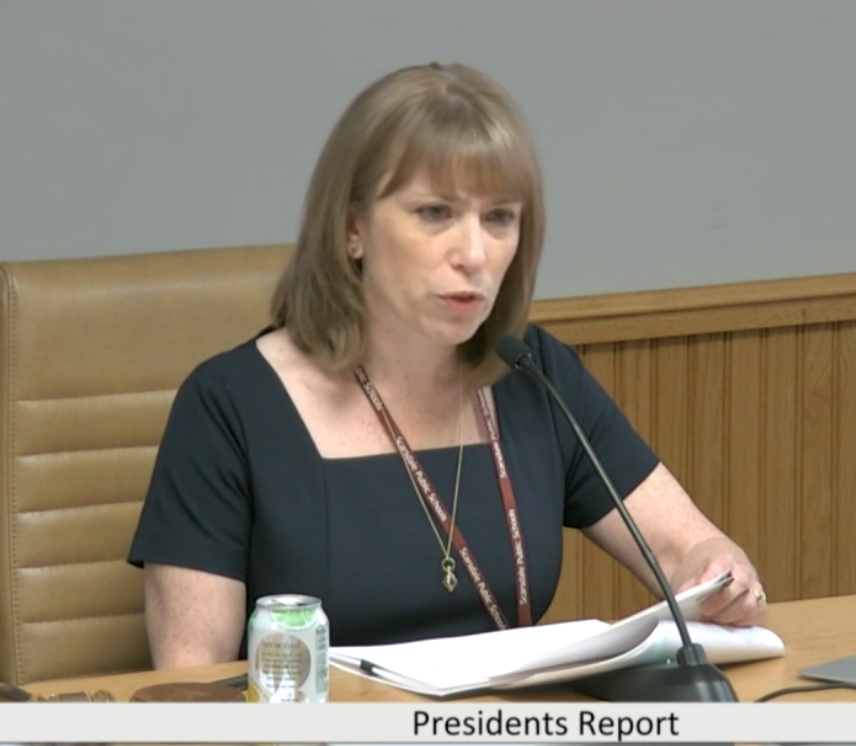 After the votes for School Board President and Vice President were finalized last week and Karen Ceske and Amber Yusef secured their leadership roles, President Ceske immediately began her work and led the first Business Meeting of her term.
After the votes for School Board President and Vice President were finalized last week and Karen Ceske and Amber Yusef secured their leadership roles, President Ceske immediately began her work and led the first Business Meeting of her term.
During her remarks, Ceske said she was thankful for the opportunity to lead the Board and excited to get started working on the District’s strategic plan and upcoming initiatives for this school year.
In his opening statement, Superintendent Hagerman congratulated the entire staff and student body on a very successful high school graduation ceremony. He welcomed new Board members Jessica Resnick-Ault and Jim Dugan and said he is optimistic about the village’s recovery from the trauma of the past 16 months. While he acknowledged that the COVID-19 Delta variant is an area of concern, the administration is keeping a close watch over the situation and will take any necessary mitigation efforts to keep students and staff safe.
The first item on the agenda was to approve the recommendations for various administrative positions, including the District Clerk, Claims Auditor, Section 504 Coordinator, Title IX Coordinator, Employees Coordinator, Records Access Foil, and District Emergency Coordinator. These positions were assigned to various members of the school board and district administration.
Next, district consultants, district attorneys, and designated depository banks were approved, and the Board was authorized to manage the Audit Committee. Following this, the Board renewed several pending authorizations, including the authorization for reimbursement of meal and lodging expenses, the authorization for milage reimbursement authorization of education travel, and the authorization of petty cash funds.
Code of Conduct
The Board then moved to review the Scarsdale Code of Conduct. The administration noted that this year’s code contained few changes from previous years and that it was reviewed by a committee comprised of administrators, high school student representatives, two Board members, PTC representatives, and the District Attorney. All students have a version of the code available in the appropriate language for their reading level available in their yearly Scarsdale agendas. New Board member Jessica Resnick-Ault found an inconsistency and noted that while the code states that visitors do not need to report to security personnel before attending PTA meetings in the high school and middle school, she does not believe that is reflected in our current procedures. Superintendent Hagerman said that this issue will be reviewed.
Textbooks
Next, the Board approved several new textbooks for the upcoming school year. The first was The Night Diary, by Veera Hiranandani, for 7th grade English. The book takes place after the partition of Pakistan and India in 1947 and tells the story of a young refugee’s search for home and her own identity. The administration noted that the English and Social Studies departments collaborate to ensure that students learn the historical background of the partition necessary to fully understand the historical context and significance of the book. The second textbook was History Lessons, by Dana Lindaman and Kyle Ward for 12th grade AT history. This book teaches U.S. history by examining historical events from the perspective of countries around the world. For example, the textbook teaches the Nigerian perspective on the European slave trade. The third book is Unlocking the Potential of Post-Industrial Cities, by Matthew E. Kahn and Mac McComas, for the high school City 2.0 course. This book examines the economic failures of six cities and asks how public and private sectors can create policies and make investments that allow a city and a population to thrive. The last approved book was Simon vs. the Homo Sapiens Agenda, by Becky Albertalli, for the 10th grade English skills class. This book is the basis for the popular film Love, Simon, and tells the story of a high school boy growing up and coming to terms with his sexuality.
After reviewing textbooks, the Board approved the food services contract renewal with the Compass Group, which is an extension of the emergency contract from this past year. The Board then adopted the 2021-2022 tax levy, the proposal for athletic training, the physical therapy and concussion management services for interscholastic athletics proposal, the CSEA transportation memorandum agreement, and the CSEA custodian memorandum agreement.
District Safety Plan
The Board then briefly discussed the district safety plan. Board Member Jessica Resnick-Ault asked if they could review the plan within a committee before approving it, however, Superintendent Hagerman emphasized the importance of having the plan approved and in place as soon as possible. He stated that the administration is committed to answering any questions and reviewing Board suggestions, but that it is important that the Board not delay the approval. Member Ron Schulhof and others noted that they would feel comfortable approving the safety plan so long as it is a living document and members can bring it up for discussion and recommend changes at any time.
Public Comments
Finally, the Board heard from resident Jennifer Zola, who was the only person to speak during any of the three public comment opportunities. She congratulated the new board members and officers, and she singled out the efforts Karen Ceske and Ron Schulhof have made this past year to keep the community informed and involved with Board work. Ms. Zola also said that she would prefer if, in the future, Board of Education meetings would focus more heavily on agenda items, and less so on using the meetings as a means of communication with the community. These meetings tend to be attended by very few members, and she pointed out that there are likely far more effective means of disbursing information to the village at large.
The Sun Sets on the Scarsdale High School Class of 2021
- Details
- Written by: Joanne Wallenstein
- Hits: 5760
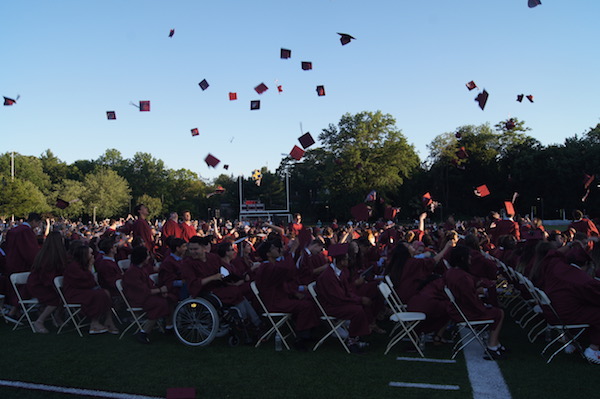 Nothing was business as usual for the Scarsdale High School Class of 2021, including their graduation, which was held on the evening of June 24th under clear skies on the high school football field. Departing from the traditional morning ceremony on Dean Field, the setting sun over the SHS field was a scenic backdrop for the commencement of over 400 graduates.
Nothing was business as usual for the Scarsdale High School Class of 2021, including their graduation, which was held on the evening of June 24th under clear skies on the high school football field. Departing from the traditional morning ceremony on Dean Field, the setting sun over the SHS field was a scenic backdrop for the commencement of over 400 graduates.
You never would have know that this was the first time the school held the ceremony at this new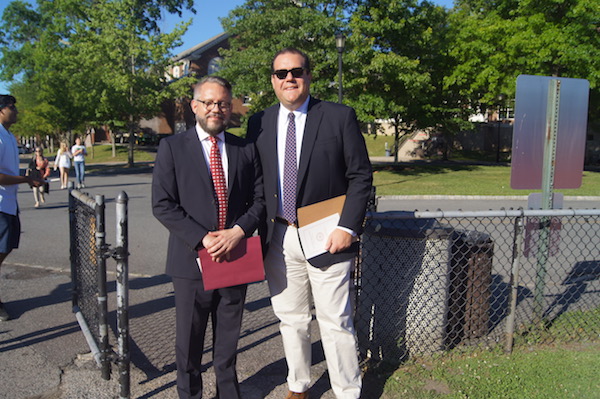 Scarsdale School Superintendent Thomas Hagerman with Scarsdale High School Principal, Kenneth Bonamo. venue. Under the direction of Assistant Principal Andrea O’Gorman and the team of deans, the event was flawless. Students formed two lines led by their class advisors Carlos Bedoya and Vincent Licciardello and marched onto the field, accompanied by the high school band. The class looked resplendent in their maroon gowns, and for the first time ever, many had decorated their mortarboards, giving the processional and even more festive air.
Scarsdale School Superintendent Thomas Hagerman with Scarsdale High School Principal, Kenneth Bonamo. venue. Under the direction of Assistant Principal Andrea O’Gorman and the team of deans, the event was flawless. Students formed two lines led by their class advisors Carlos Bedoya and Vincent Licciardello and marched onto the field, accompanied by the high school band. The class looked resplendent in their maroon gowns, and for the first time ever, many had decorated their mortarboards, giving the processional and even more festive air.
Board of Education President Pamela Fuehrer opened the program, acknowledging that the class was “leaving the school in a way never done before.” She said that during her tenure as Board President she has seen an “increase in student voice,” and credited the class with stepping up and making an impact. She said, “This class has shown us that you know how to be good citizens….that you know how to live with people who live differently than you.” She encouraged them to “continue to be curious and explore different things… to be brave and say yes even when you’re not so sure…. so much happens just outside your comfort zone. Go there.
Senior Class VP Anya Kornfeld also noted the unusual year. She said, “This year has been far from traditional. And yet we bent in a way so that we did not break…. We were truly able to make the most of Scarsdale High School. “ She continued, “A principal theme was resilience and the ability to adapt to any situation.” She thanked her teachers who “never shied away from a challenge and helped us each to create our own unique path to success.”
Social Studies Teachers and Class Advisor Carlos Bedoya said, “While it is natural at this time to look back nostalgically at what has been, even to feel a sense of loss, it is important to remember that endings create possibilities for new beginnings. You, the class of 2021, understand most acutely, that all things change.
Vincent Licciadellos said, “As some of you know, I have the great pleasure of teaching physics. And, in my class, one of the first things we address is how our universe is a dynamic one. That is, in our universe, things change. A particle is here and then it is not. It moves at one velocity and then another. It possesses one set of energies and then another. But, it is not just the physical universe that changes.
In this past year, we have all shared in the incommunicable experience of a global pandemic. This experience presented your class with unique challenges, thrusting changes on all of you that were neither expected nor coherent, creating unanswerable questions no classroom activity could solve. We hope that through all of this, you may come to understand that while knowledge is gained through studious-ness, diligence, and focus, wisdom is earned from lived experiences and the quiet navigation of the uncertain.”
“Great change also happens in the social universe. Indeed, we - your faculty, staff, administrators, and caregivers - have watched you all change over the last 4 years. We have seen you become better critical thinkers, as shown by your ability to answer the increasingly complex questions we have posed of you. We have seen you become more adept at helping others, as shown by what you have accomplished through government, clubs, and beyond. And, we have seen you become more resilient, as shown by how you negotiated this most unprecedented of academic years.”
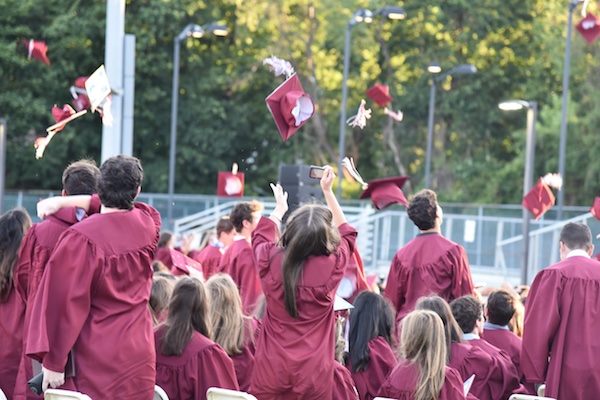 “And now even greater change awaits you. It will be precipitated by confrontation with even more complex questions, by an even greater need to help others, and by even more resilience in the face of adversity to overcome it.”
“And now even greater change awaits you. It will be precipitated by confrontation with even more complex questions, by an even greater need to help others, and by even more resilience in the face of adversity to overcome it.”
Bedoya continued, “So to that charge, we are excited to see what changes all of you will bring into the world. As you confront the challenges ahead that your generation must address, you will be faced with many questions. We only ask that you heed the words of the poet Marie Rainer Rilke, who reminds us to “have patience with everything unresolved in your hearts, and try to love the questions themselves. Don’t search for the answers, which could not be given to you now, because you would not be able to live them. And the point is, to live everything. Live the questions now. Perhaps then, someday, far into the future, you will gradually, without even noticing it, live your way into the answer.”
Senior Class Treasurer Emily Aaron introduced class co-presidents Emmet Goldstein and Aaron Wasserman. She said, “These were years marked by drive, grit and flexibility…We have created many new senior traditions. I am proud to be part of this year’s senior class… No task was easy, but our class presidents handled them with ease and grace.”
Goldstein and Wasserman said, “We all knew how challenging this year was but we appreciated it. We realize how much we treasure this year and each other… In the aftermath of the confusion our class came together like never before. We salvaged our senior events and made them feel normal…. We entered school on April 19 … we tore up the floor at Prom… and we performed an awesome senior class play.
We cherished reuniting with our class. We cherished spontaneous conversations before class…. And a botched parking job!
As we look ahead to our adult lives we are prepared in many ways. Our school motto Non Sibi taught us the importance of community. We practiced resilience and not only survived Covid, we thrived. We have proven that we are ready for each of life’s challenges.
In a short period of time we will each go our separate ways but we will stay connected, even when apart.”
SHS Principal Ken Bonamo provided parting words, before School Superintendent Thomas Hagerman certified the graduation and diplomas were distributed.
Bonamo said, “Today is a special day marks the culmination of your childhood education and the beginning of adulthood. We hope we have given all that you need to succeed and we are filled with anticipation of what the future holds.”
“How truly wonderful it is to be together on such a wonderful evening…. Please let us pause to let the beauty of this instant sink in.”
“Sometimes the business of life detracts from what is most important. I urge you to make a healthy balance between time spent with others and time spent with yourself.”
“Scarsdale values active citizenship, civic engagement and respectful debate. Critical thinking, global dependence, a genuine love of learning are the goals that have guided us.”
“As you confront the challenges of our world I hope you will endeavor to make the world a better place. It should be clear that regardless of what side you take of any issue, you will need courage. You will continue to find your voices. You will need to stand up, even to stand out.”
I urge you to build a legacy filled with love. Infuse love into your work, your relationships and your self-regard. You should look at yourself and love what you see … an intelligent, responsible curious person poised to take on the challenges of life.”
With that, Superintendent Thomas Hagerman asked, "Have these seniors met the requirements for high school graduation imposed by the Regents of the State University of New York, the Commissioner of Education and the Board of Education?" He certified them as graduates of Scarsdale High School, bid them to go forth and with that, the distribution of the diplomas began.
Perhaps an evening graduation will be the legacy of this era, as it was a beautiful time of day to celebrate the class.
If you would like to add your photos to our galleries, please email them to scarsdalecomments@gmail.com.
 Coverage of the Class of 2021 Scarsdale High School Graduation was sponsored by Lisa Weissman and Bela Sheth of Houlihan Lawrence in Scarsdale.
Coverage of the Class of 2021 Scarsdale High School Graduation was sponsored by Lisa Weissman and Bela Sheth of Houlihan Lawrence in Scarsdale.
Maroon and White Celebrates Senior Athletes
- Details
- Written by: Joanne Wallenstein
- Hits: 4283
 Iron man awards were given to four year, three season athletes.Though there was no barbeque this year, there was a joyous celebration for outstanding athletes and scholars in the Scarsdale High School Class of 2021 on Monday June 14, 2021. At a ceremony in the SHS auditorium, which is still adorned with plexiglass shields, Maroon and White and the high school athletic department recognized the achievements of seniors who had distinguished themselves during their high school careers
Iron man awards were given to four year, three season athletes.Though there was no barbeque this year, there was a joyous celebration for outstanding athletes and scholars in the Scarsdale High School Class of 2021 on Monday June 14, 2021. At a ceremony in the SHS auditorium, which is still adorned with plexiglass shields, Maroon and White and the high school athletic department recognized the achievements of seniors who had distinguished themselves during their high school careers
Athletic Director Ray Pappalardi and Assistant Athletic Director Joe DeCrescenzo from the high school, along with Kevin Hooey and Joe Feldman, filling in for David Alin, from Maroon and White presented the awards to the students.
Pappalardi acknowledged it was a difficult year, but was pleased that 58% of Scarsdale High School athletes were able to participate in team sports. He said, “Though we knew it would not be perfect, it was far better than the lost spring season of 2020.
Kevin Hooey thanked Maroon and White members and said that the booster organization is now in its 53 year. Their primary objective is to support Scarsdale student-athletes when certain equipment and team needs go beyond the school budget.
The first awards were given to Raider’s Iron Men -- student athletes who participated in three seasons of high school sports from grades nine through twelve.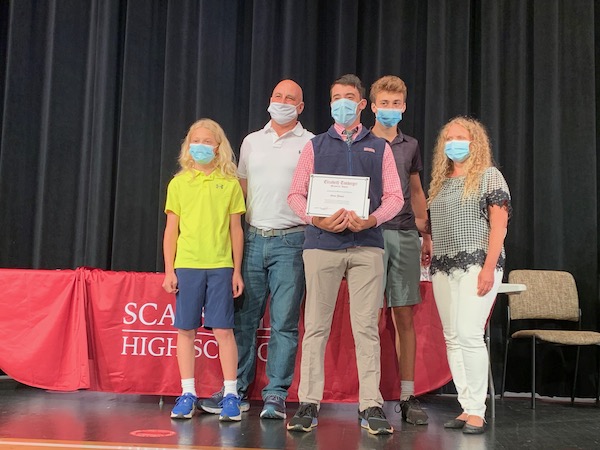 Football team manager Aaron Zoland received the Timberger Award
Football team manager Aaron Zoland received the Timberger Award
Receiving the Iron Man awards were:
Walter Jake Coleman
Hudson Crane
Shan Daniel
Alexa Doyle
Edward Eforo (not pictured)
Alex Friedman
Benjamin Hoexter
Bradley Kauffman
Madelyn Seltzer
Abigail Talish
Michael Waxman
Recognizing students who plan to play a sport in college, Maroon and White called out the following athletes:
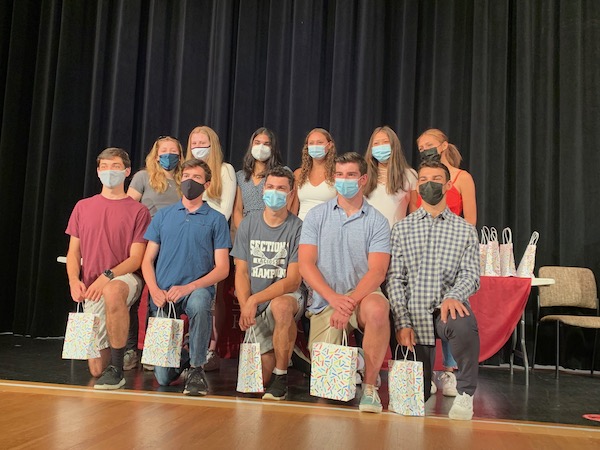 Athletes recruited to play on college teams.Charles Berridge will play golf at Berkeley
Athletes recruited to play on college teams.Charles Berridge will play golf at Berkeley
Jake Coleman will run track at UC San Diego
Shan Daniel will run track at Case Western
Justin DiSanto will swim for Bucknell
Danielle Eforo will swim at Wesleyan
Julian Higgins will play football at Case Western Reserve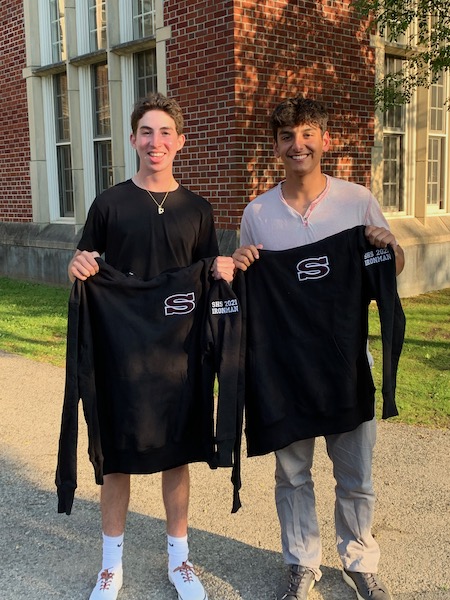 Iron men Ben Hoexter and Bradley Kauffman show off their Raiders sweatshirts.
Iron men Ben Hoexter and Bradley Kauffman show off their Raiders sweatshirts.
Joy Jiang will swim at University of Pennsylvania
Brendan Knopp will play football at Franklin and Marshall
Melissa Lass will cheer at Lafayette College
Megan Lee will swim for Amherst
Steven Lee will golf for the University of Pennsylvania
Ben Miller will play football and lacrosse at Bates College
Anya Pabby will swim for NYU
Maddie Seltzer will swim and dive for Princeton
Emily Ann Tsai who will play tennis at Franklin and Marshall
Van Eer Yurami will run track at Union College.
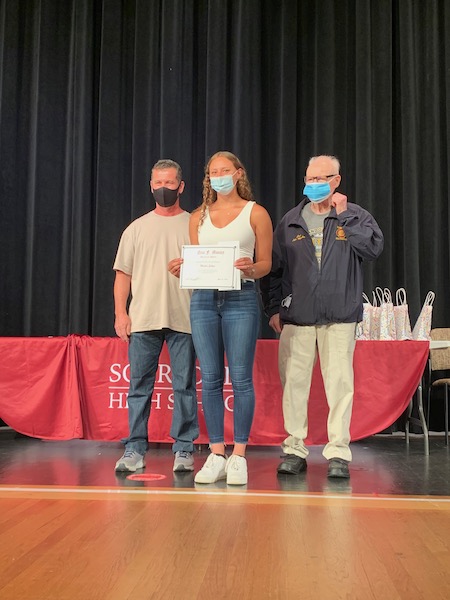 Maddy Seltzer received the Mooney AwardThey moved on to the Timberger Award, named for Elizabeth Timberger who served on the board of Maroon and White and was an enthusiastic rooter on the sideline. She died at young age. This award honors someone who help the team, whether they be a manager or a sports writer. This year, the award was given to Aaron Zoland who managed the Boys Varsity Football Team. Zoland was said to be a person of few words, always calm who was focused on the team’s success and would do whatever he could to make things better for the team.
Maddy Seltzer received the Mooney AwardThey moved on to the Timberger Award, named for Elizabeth Timberger who served on the board of Maroon and White and was an enthusiastic rooter on the sideline. She died at young age. This award honors someone who help the team, whether they be a manager or a sports writer. This year, the award was given to Aaron Zoland who managed the Boys Varsity Football Team. Zoland was said to be a person of few words, always calm who was focused on the team’s success and would do whatever he could to make things better for the team.
Joe Feldman presented the Nina Mooney award for Mooney who passed away at the age of 54 in 1991. According to Feldman, she lived a “boisterous, happy, existence,” and had a “perpetually open house on Bradley Road. She was both “fun and feisty, and loved organizing Maroon and White events. “If you knew her you were part of her family.”
The winner of the award, Maddy Seltzer, was called a team player who excelled in her individual role and as a great role model. She was a Civ Ed advisor, won the Con Edison award, and was an all-American swimmer. She graduated with a 3.8 GPA and will attend Princeton.
Kevin Hooey, surrounded by members of the Knopp family, presented the Knopp Award in honor of Mary Knopp who lived in Scarsdale for 20 years. She cheered on four sons from the sidelines and showed unwavering support for athletics as a member of Maroon and White for ten years.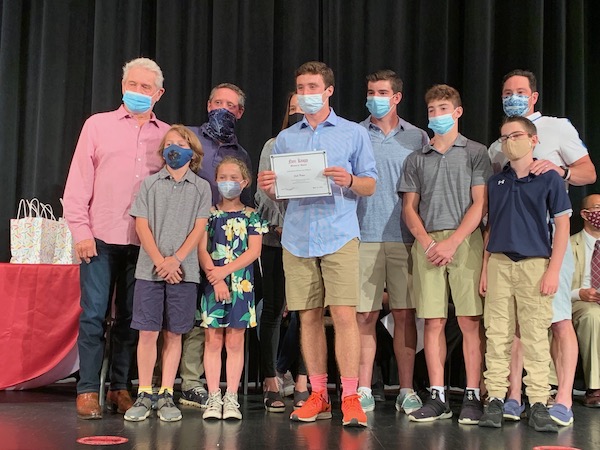 Jack Porter with the Knopp Family
Jack Porter with the Knopp Family
The Knopp award is given to a male senior varsity player for dedication, spirit, enthusiasms, concern for others and a positive work ethic.
As it was daunting to select only one athlete, this year, two Knopp awards were given to track star Jack Porter and to Mary Knopp’s grandson and football standout Brendan Knopp.
The Grant Geiger award recognized athletes who are dedicated to their sport and also dedicated to their studies. The award is given to athletes who earned a 3.5 GPA or higher. This year’s awardees are Victoria Wilson and Adam Wasserman.
Ray Pappalardi presented the Athletic Director’s awards, giving the Raider award to Ben Miller for his work ethic, resilience, leadership and being an athlete “anyone would want on their team.” He said that Miller, “refused to lose, never quit and led by example.”
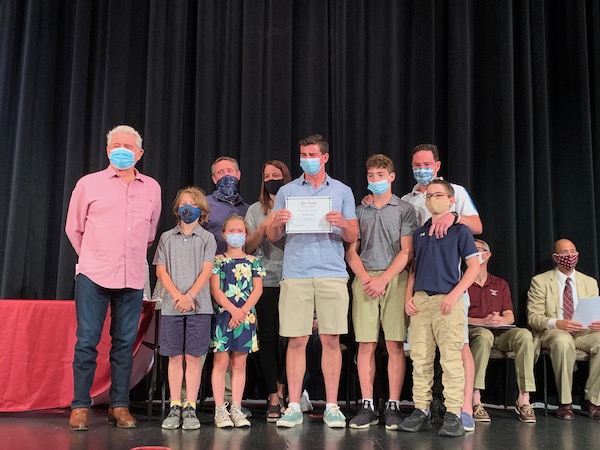 A proud moment for the Knopp family, as Brendan receives the award.Also recognized by the Athletic Department was Scarsdale Tennis Team captain Zoe Tucker, for embracing the role of captain and getting along with everyone.
A proud moment for the Knopp family, as Brendan receives the award.Also recognized by the Athletic Department was Scarsdale Tennis Team captain Zoe Tucker, for embracing the role of captain and getting along with everyone.
The Peppers award, named for former SHS Assistant Principal Sue Peppers and her husband Jerry who raised four girls in Scarsdale is given to a male and a female athlete who is a team player with strong academics. This year’s winner was Abigail Talish, who graduates with a 4.1 GPA, is a national merit finalist and a three sport team captain. On the basketball team she was a starter for three years and led the team. She will attend Columbia University.
Michael Waxman, a three season athlete and President of the Scarsdale High School student body took home the Peppers Award as well. He was described as “kind, caring, disciplined, polite and a great kid to have on the team.” With a 4.1 average he is in the honors society and won the Principal’s Award. He will attend Harvard University. Athlete and honor student Abigail Talish with the Peppers Award
Athlete and honor student Abigail Talish with the Peppers Award
Though Maroon and White did not have the chance to honor all the spring athletes this year, they were pleased to be able to hold the ceremony and carry on this SHS tradition.
 School President, three season athlete and Harvard bound Michael Waxman won the Peppers Award.
School President, three season athlete and Harvard bound Michael Waxman won the Peppers Award.
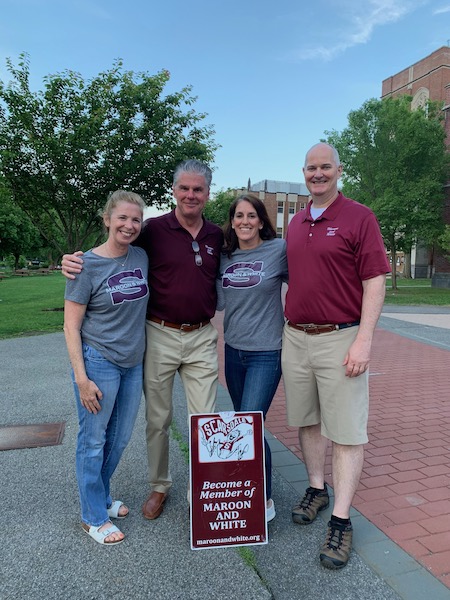 Deb Franco, Kevin Hooey and Kate and Matt Conlan from Maroon and White
Deb Franco, Kevin Hooey and Kate and Matt Conlan from Maroon and White










